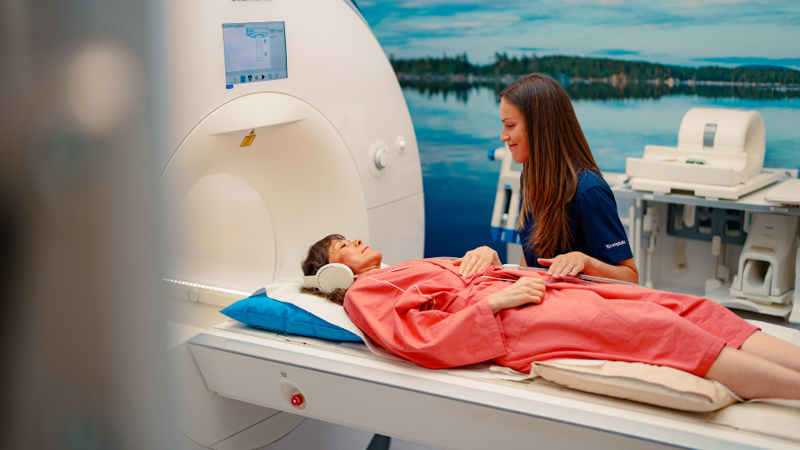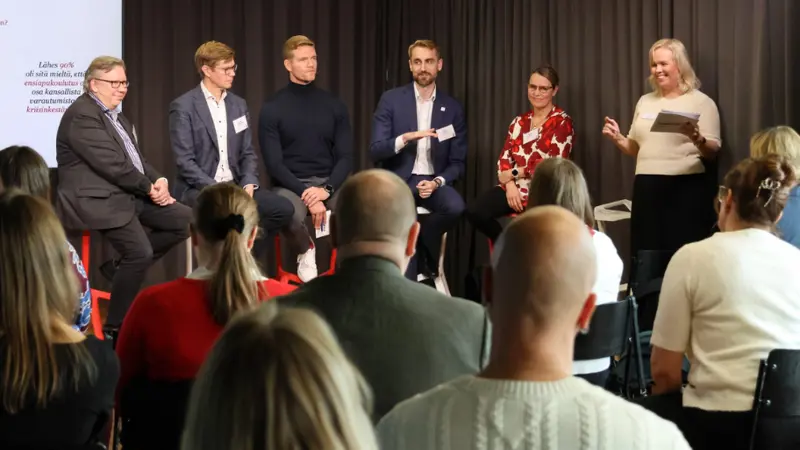Prepare for an occupational healthcare plan now!
Industries and the nature of work vary, and each workplace is unique. Therefore, every organization also has its own needs related to occupational health. The occupational healthcare plan that is drawn up annually in cooperation with occupational health defines the needs, actions and goals of occupational health and the measures based on them.

Before the occupational healthcare plan is drawn up, a workplace survey is carried out in cooperation with the workplace to survey the conditions of the workplace. The workplace survey assesses the significance of load factors, resources and hazards related to the working environment, work and the work community for the employees’ health and work ability. At the same time, it is determined, for example, whether the first aid preparedness at the workplace is sufficient.
At Terveystalo, the Healthy Workplace™ cooperation model, consisting of four components, helps employers to draw up an action plan. For a healthy workplace, each of the four elements - healthy work, well-being, a well-functioning work community and active leadership - must work. If any one of these is weak, it will affect the others and undermine the whole, as each has a role to play in building a healthy workplace. The workplace survey identifies how different areas should be emphasised in each organisation to best serve the success, development and goals of the business.
Workplace surveys and occupational health action plans are the prerequisite for reimbursement of occupational health
The law requires the employer to have a written occupational health action plan and a workplace survey. The workplace survey and action plan are ongoing activities, and their up-to-dateness must be checked annually.
These official-sounding measures are a great place for interaction and open discussion. The best results are achieved through cooperation: information and reports collected in occupational health are used when evaluating previous measures and planning new ones.
An up-to-date workplace survey and action plan are also a prerequisite for Kela compensation* for occupational health investments and costs. For example, employers are reimbursed for the costs of maintaining first aid preparedness when the needs for first aid preparedness and training have been assessed by the occupational health service, are included in the action plan and the trainer is a health professional.
Tips on how to prepare for building an occupational healthcare action plan
Terveystalo’s occupational health contact person is in contact with customer companies whose financial period is a calendar year during the fall and with customer companies whose financial period differs from the calendar year in the spring to build an action plan. In order for the goals of occupational health to support your organization’s operations in the best possible way, you should prepare for the meeting by considering the following things.
1. Have there been any changes in the operations and operating environment of your organization during the past year, or are there any changes planned for the coming year?
How is work done in your organization now and in the future? For example, have you implemented a hybrid model in which remote work and in-office work are regularly combined? Or are there any business activities in your organization where the work is mainly in-office work, or is work done in shifts in your organization? You may have introduced new types of tools, machines and devices that have changed the load and movement trajectories in physical work. Or is there an upcoming change related to working methods and the introduction of a system that supports this?
The specificities of different industries and workload factors are best identified through targeted health checks, which help to identify potential work ability challenges proactively and at an early stage. In addition, it is necessary to review the changing situations with occupational health so that their effects on the physical and mental load of the personnel can be taken into account in the action plan. Especially now that the law on safety at work has been updated, employers must more systematically assess workload factors and take measures to extend working lives and improve job satisfaction.
- Physique and movement at work and The mind and work health examinations
- Change management support
- Work ability coaching to support your employees
2. Involve your personnel and collect feedback and experiences of occupational healthcare cooperation
Do the personnel have needs that require support or training? Depending on the size of your organization, group the feedback according to the needs of supervisors/managers and the entire personnel. We've yet again faced a year of extraordinary events and no doubt has it been demanding for front-line staff in many places. Do they need more support and coaching in their management work, or are there challenges in staff morale? The low threshold mental wellbeing service and brief psychotherapy are effective means to improve personnel mental wellbeing and functioning, reducing mood symptoms, supporting return to work and preventing the need for sickness absence.
If the need for support to adopt a healthier lifestyle arises, it is worth discussing with occupational health how best to use the expertise of a multi-professional team - such as nutritionists and sleep coaches - in preventive work.
- Development of supervisory work
- Support in workability management
- Mental well-being for all personnel
3. What do you hope for from the cooperation, what priorities should the cooperation focus on?
In order to keep the work ability of your personnel high, think about what things should be invested in. When the action plan is built together, it is possible to prioritize the most effective measures and to schedule their implementation in a timely manner.
*More information on Kela’s website about the workplace survey and action plan in Finnish
Latest articles

Terveystalo's digital services have been awarded the internationally recognized ISO27001 information security certification.
Terveystalo's information security practices, processes, and risk management are in line with international best practices.

Does massage help relieve stress? – Touch restores and calms the body and mind
Stress is not always visible on the outside, but the body does show signs when the strain increases. According to Lassi Ylönen, a trained massage therapist at Terveystalo Rela, the body often communicates stress through subtle signs.

Circular economy and artificial intelligence boost performance and improve care
At the heart of sustainable healthcare, technology serves as a tool for improving both the quality of care and accountability. Terveystalo favors solutions that combine sustainability, cost-effectiveness, and medical expertise.

Psychologist: How to make Christmas a relaxed and personal celebration
For many, the anticipation of Christmas begins when cities are decked out in seasonal lights and the first chocolates, calendars, and gingerbread cookies appear on store shelves. Christmas carols ring out and the Tonttuparaati choir sings “Kiire jo on! Kiire jo on!” (Hurry up! Hurry up!). This warm and atmospheric celebration also brings other feelings to mind: how on earth can we get through all this without losing our joy and peace in the rush?

Terveystalo and Gosta Labs deepen their cooperation: the goal is to streamline work with a superior patient information system
Terveystalo is deepening its cooperation with Finnish health technology company Gosta Labs and investing €1 million in the company as a minority investor. The aim is to jointly develop artificial intelligence solutions that improve the quality of care and the efficiency of reception work as part of Terveystalo's new patient information system, Terveystalo Ella.

First aid preparedness in companies requires action and courage
First aid skills increase resilience, but a barometer survey of Finnish organizations' first aid capabilities published in October reveals that the number of trained personnel is alarmingly low.